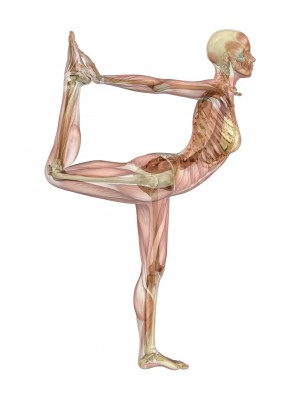
My colleagues Dr. Alexes Hazen, Tamar Amitay, MSPT, and I recently found ourselves emerged in a discussion about bones. Our bones are fascinating on many levels, and we, the doctor, physical therapist and yoga teacher, would like to inspire you as we examine them from a physiological, anatomical and metaphysical standpoint. For starters, here is an issue we would like to address. Our bones are living, breathing tissue; they are NOT the hard, brittle, skeletal parts we occasionally saw dangling from a rolling hook in the school science lab. If we are unknowingly holding this inaccurate image in our minds, then we are also unknowingly maintaining an unhealthy mind-body relationship with our bones. If you believe, and many of us do, that the mind plays an important role in our health, then we need to be sure that we imagine our bones in all their glory and that we learn to cultivate a therapeutic, working relationship with them as we age.
Alexes says, "We tend not to think of our bones as a living organ -- but they are very much alive. In addition to providing structure for our body, they protect all our important organs and help us nourish our entire body with the creation of red and white blood cells. Very much alive, turning over their cells and composition on a regular basis, our bones are literally changing every day."
A medical study in The American Journal of Physiology suggests that the oxygen supply to our bones directly affects bone formation and bone physiology. In my breathing workshop, I am always reminding my students that our breathing is supplying the oxygen to every single cell in our body. When it comes to delivering oxygen to our breathing bones, the supply is either helped or hindered by our alignment -- this is where Tamar comes in. As a physical therapist, Tamar helps people find efficient and neutral body alignment because she knows that proper bone alignment optimizes breathing. Tamar points out that poor posture is often the result of muscular imbalances due to repetitive activities or positions without reprieve. Think of spending hours bent over a computer without a break, or carrying a heavy purse on the same side of your body every day. If the skeleton is not aligned and no longer efficient it will not only cause discomfort and damage to joints, organs and muscles, but will also infringe upon the diaphragm's ability to do its job.
Tamar says, "Ideal postural alignment comes from being upright against gravity so that your bones fit properly with one another. An optimal distribution of forces on bones and joints allow your muscles to relax and minimizes stress on your tissues. Efficient and neutral body alignment optimizes breathing, allowing the lungs to expand and the diaphragm to descend for inhalation. Proper posture allows the musculoskeletal system to function with minimal muscular effort and zero give."
As Tamar talked about the relationship between bone alignment and muscle efficiency and their influence on our breathing body, she reminded me that when it comes to our bones and muscles, including the muscles involved in breathing, we are very much a system of checks and balances.
Dr. Hazen pointed out that the bones are a regulator of many bodily functions and that they need to be supplied well with oxygen in order to play their role in our health. Our bones are involved in the regulation of blood sugar levels and hormone levels and they participate in calcium metabolism as well. She feels it is important for us to know and remember that without the exchange of healthy oxygen coming in and carbon dioxide leaving, our bones cannot do all the things they need to do in an efficient way. She also noted that people who have lung disease often have very bad osteoporosis.
Our breathing and our bones work in tandem and play an important role in keeping us healthy. When our bones are positioned well and our breathing is optimum, oxygen can be supplied more efficiently to our whole body, including the bones themselves. It is a beautifully balanced system with each part depending on the other in order do its job well.
Alexes, Tamar and I are all in agreement that if you become familiar with your bones and postural tendencies you will not only help yourself heal and avoid future discomfort but you can also enhance the efficiency of your breathing and live a more mindful, healthier life. The more we learn about our bodies, the more we can become partners in our health and wellbeing. Good doctors, therapists and teachers help people to build and foster these important mind/body relationships because we know that they are self-empowering and emotionally uplifting.
Since I have dedicated a large part of my life to being a cheerleader for the cause of conscious breathing and mindful movement. I am more than delighted when Dr. Hazen says, " Healthy breathing makes for healthy bones!" and when Tamar claims, "Your bone positioning affects the quality of your breathing."
In conclusion, please check in with yourself, and be sure that when you think of your bones
(and I hope you do so often) that the image in your mind is one of strong yet supple and malleable living tissue, full of activity, and rich with fluid, flowing purpose -- because then I am sure that you will develop a lifelong dedication to their care. We do have an emotional relationship with our bodies, and if you ascribe to the notion, "as I think, so I am," then it's best that you think well. Whether we wish to acknowledge it or not, we are involved in an emotional relationship with our entire body all the time.
For more by Carla Ardito, click here.
For more on wellness, click here.